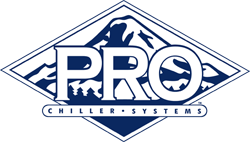Propylene Glycol is simply a Food Grade Antifreeze, required when a food product is being cooled and there is a chance of direct contact between the two mediums. The glycol, mixed with city water, enables us
to operate our chiller systems in the 20 F-35 F Design Operating Temperature Range.
Pro recommends that all of our chiller systems are operated with
ProChill Heat Transfer Fluid
, and inhibited glycol with corrosion and rust inhibitors.
Click here to purchase ProChill Heat Transfer Fluid.
PRO recommends to maintain a glycol freeze point of between 20-25 F below your chiller setpoint. In 90% of applications this equates to a 33% Glycol Concentration. In colder climates you may need to operate with a stronger concentration, but keep in mind
the stronger the concentration the lower your system cooling efficiency.
The temperature of the refrigerant will be 10° to 15° F below your Chiller System setpoint temperature. So with a +27° Glycol Temperature, your refrigerant temperature is probably +12° to +17° F.
We require the freeze level of your Glycol/Water Solution to be 20°- 25° F below your chiller system setpoint.
Example: CHILLER SETPOINT: +27° FAHRENHEIT
GLYCOL FREEZE LEVEL: + 7° to +2° FAHRENHEIT
In colder climates make sure that the glycol freeze level is lower than extreme ambient conditions. We do not require the freeze level to be 20 F. below winter extreme conditions.
Most Pro Chiller customers will operate with a 35% Glycol to 65% Water Solution. This will protect the Glycol/Water Solution from freeze up to +1 F.
Click here for our glycol freeze point concentration chart
The amount of glycol will vary in each application. When attempting to calculate the amount of glycol need make sure to factor in addition to your glycol tank capacity, piping capacity, vessels heat exchangers volume, etc.
Calculating your total system volume can be tedious but an improper glycol percentage will greatly affect the systems operating efficiency. A rough estimate can be calculated by adding the estimated volume of your total system piping, plus your tank jackets,
and the reservoir size on your chiller system. Your plumbing contractor and tank manufacturer can help with piping and jacket volume estimates- the chiller system tank capacity should be listed in the owner
manual or by calling the factory at 800.845.7781 and providing your system Serial and Model number.
After you've calculated the rough estimate, we suggest you add propylene glycol and water at a 50/50 concentration until your storage tank is at least 50% full. Allow the system to circulate for 15 minutes and then check the percentage using a refractometer.
The chart below provides conversion to degree brix. Based on this reading you can then adjust the ratio of glycol to water to complete the charge of the system. For most applications a freeze point between
0 and +5 F is ideal.
Click here for our glycol freeze point concentration chart
For more information please refer to our
all about glycol
article.
MCA is the Minimum Circuit Ampacity (It is chosen to guarantee that the wiring will not overheat under the expected operating conditions. The MCA is not the normal operating current, but used for selecting wire sizes) 125% of the largest motor FLA + the
remaining sum.
MOP is the Maximum Overcurrent Protection (The maximum overcurrent protection (MOP) is the maximum circuit breaker / fuse size required to properly protect the equipment under anticipated fault conditions.) 225% of the largest motor FLA + the remaining
sum.
You will find the MCA and MOP ratings inside the electrical control panel. Your electrical power supply must be larger than the MCA and smaller than the MOP.
Immediately upon receiving shipment, equipment should be inspected for evidence of any damage received in transit. If shipping damage has occurred, a claim should be made with the transportation company, and your equipment representative should be advised
of the nature of the damage. Each System is supplied with Refrigerant Pressure gauges, simply note on the packing slip if either of these gauges indicates a loss of pressure. System pressure will vary depending
on outside temperature, but should be between 50 and 100 PSIG.
Equipment covers should be removed as soon as possible and the system inspected for shipping damage. Even if you have signed off on the packing slip there is still a short window to report any damage and file a claim with the transportation company. Please
confirm the name plate data (located within electrical control panel) matches the original order acknowledgment (equipment model numbers, voltage, refrigerant, etc.).
As a manufacturer, Pro does not provide installation service of their system. Pro does offer to provide Factory Start Up Assistance on each system, we will work with your installation and service contractor to make certain the unit is installed correctly
and operating at maximum efficiency from the start. Factory Start Up is offered for $1250 per day plus travel expenses.

